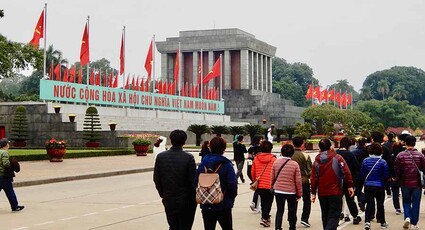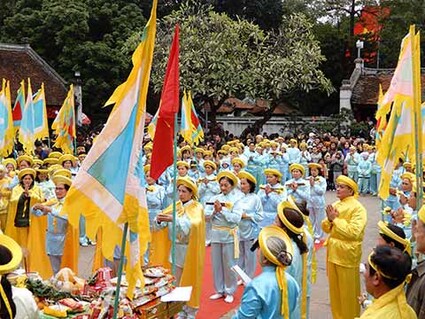Hanoi, a half century later
Last updated 6/9/2020 at Noon

Craig Eisenbeis
The Hanoi mausoleum of Ho Chi Minh, who is considered to be the Vietnamese equivalent of George Washington.
On our coronavirus-truncated Asian cruise tour, the final stop in Vietnam was at Halong Bay, gateway to Hanoi and home to the giant, picturesque, monolithic rocks frequently seen in travel photos and more recently made famous in the filming of the movie “Kong: Skull Island.”
I never imagined myself visiting Hanoi, much less on a tourist bus; but there I was, bound for Hanoi on a six-lane freeway. As we passed through the busy port of Haiphong, I clearly remembered the U.S. mining of Haiphong Harbor in 1972. The Coast Guard Cutter, to which I was assigned at that time, was in the middle of the Pacific; and I recalled wondering if the war’s escalation would place us in any direct peril. My concern was unfounded, but we had no way to know that at the time.
As we entered Hanoi from the east, it was hard to conceive that, 50 years ago, the U.S. was raining bombs down on this city of 7 million. We saw the lake over which John McCain was shot down on his way to bomb a nearby power plant. We saw the infamous “Hanoi Hilton” where the future senator and presidential candidate was imprisoned for more than five years.
Our guide reverently explained that the Vietnamese hold John McCain’s memory in very high esteem for his courage, his refusal to accept early release unless his fellows were also released, and for his later return and role in ending U.S. sanctions against the country. It was interesting to note that the guides always referred to war and bombings “by the U.S. government” rather than by “the Americans.”
Ha Noi, like Viet Nam, is two words in their language and has been the country’s capital since the year 1010. It’s another large Asian city with impressive architecture and an excellent lager beer called “Bia Ha Noi.” There has been much rebuilding since the war, which now includes an actual Hilton Hotel.
We toured the site of Ho Chi Minh’s mausoleum and memorial grounds, along with Ho’s house and Presidential Palace which are across the street from Parliament. In Vietnamese history, “Uncle Ho” is their equivalent of George Washington.
We visited Hanoi on the fifth day of the Lunar New Year celebration and stumbled into a huge festival attended by hordes of people, including a large prayer-for-peace assembly of sky-blue, silken-clad worshippers at the Temple of Literature, which was built in 1070 and dedicated to Confucius. The celebrants also prayed for success and health in the new year.
Downtown Hanoi was teeming with people, noise, and motorbikes, as our guide led us through narrow back alleys and markets of the city. There is an interesting blend of Asian and French architecture, a legacy of the French colonial period. At the end of our guided tour, we were turned loose to wander the city’s waterfront for about an hour before our departure. Shops in this area were neat but old, crowded, and utilitarian; and they accepted credit cards.
Exploring on our own, we discovered a small park with an impressive monument dedicated as a memorial to the men and women who lost their lives in the struggle for Vietnamese independence. The sculpted figures depicted were in the robust proletarian style similar to monuments we have seen in Russia and the former East Germany.
When the bus finally arrived to pick us up for the return to the ship, it had been a long 12-hour day; but the cooler temperatures of the north made it more pleasant compared to the heat of the south. It was amusing to see that thermometer readings in the 50s caused many of the Vietnamese to bundle up in Eskimo-style parkas.
By the time the bus hit the road, many of the passengers were asleep and missed the spectacular night lights of Hanoi. The beautiful new buildings were gloriously lit at night, not nearly rivaling, but reminiscent of Las Vegas. Arriving back at our moorage in Ha Long Bay, we were greeted by the brilliantly lit suspension bridge and amusement park adjacent to the pier.
This was late January, and most of the intelligent world was already taking steps to control the novel coronavirus that would soon result in our subsequent two-week cruise to nowhere. Although our next port of call, Hong Kong, would never achieve status as a high danger area for the virus, the cruise line canceled an overnight stay there. We stayed an extra night in Vietnam and stopped in Hong Kong only long enough to pick up and discharge scheduled passengers.

Craig Eisenbeis
Celebrants in Hanoi gather at a thousand-year-old temple, dedicated to Confucius, to pray for peace and prosperity in the new year.
All organized tours in Hong Kong were canceled, but we were given the opportunity to take city bus tours and the ferry to Kowloon on our own. One of the most densely populated places on Earth was not exactly a ghost town, but traffic and outdoor activity in Hong Kong was extremely light. Residents were already practicing sanitization and social distancing measures, and everyone — except the tourists — wore masks.
Stopping in Hong Kong was a strategic error because, since we had touched port in China, no other nation would take us in. So, for the next two weeks, we wandered the South China Sea. Rejected by all our future ports in The Philippines, Taiwan, South Korea, and Japan, our cruise — originally scheduled to terminate in Shanghai, China – finally ended with a return to Cambodia, which agreed to grant us refuge. Accounts of the Westerdam’s “Ghost Ship” cruise to nowhere can be viewed in past articles at www.nuggetnews.com.
















Reader Comments(0)